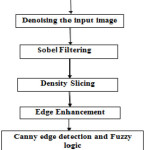Introduction
Digital image processing is the use of computer algorithms to perform image processing on digital images. Edge enhancement plays a vital role in Digital image processing. Edge enhancement is a pre-processing technique for all images. It is planned to perform automatic edge enhancement in indoor digital images. Indoor images can be generated by using Digital camera. The characteristics of digital images justify the importance of an edge enhancement step prior to edge detection. Therefore, a robust and unsupervised edge enhancement algorithm based on a combination of wavelet coefficients at different scales can be applied. Firstly, wavelet transform is used to remove noises from the image collected. Secondly, the edge detection can be performed in enhanced digital images by Canny edge detector. A double thresholding method modified from Canny’s method can be used. To derive the final image, the local intensities of each image, as well as their correlation must be taken into account using the fuzzy logic.2
The existing work of the proposed method is Edge enhancement in SAR images. A technique for automatic edge enhancement and detection in synthetic aperture radar (SAR) images is present in the existing system. The characteristics of SAR images justify the importance of an edge enhancement step prior to edge detection. Therefore, existing system presents a robust and unsupervised edge enhancement algorithm based on a combination of wavelet coefficients at different scales. The performance of the method is first tested on simulated images. Then, in order to complete the automatic detection chain, among the different options for the decision stage, the use of geodesic active contour is proposed.
The method used in existing system based on a different way of managing multi-scale data. Moreover, it does not assume any statistical distribution of the input data nor any particular type of edge, and it works exclusively in the transformed domain. The study present in existing system is based on a threshold operation of wavelet coefficients. Despite a low computational cost and a good contrast, detected edges are too thick. The approach tackles the robustness and the precision issues of edge enhancement and detection at the same time.
The second part of existing work suggests the extraction of the Coastline in SAR images as a particular case of edge detection. Hence, after highlighting its practical interest, the technique that is theoretically presented in the first part of this paper is applied to real scenarios. Robust edge detection techniques are essentially based on the following two steps: edge enhancement and decision. Unlike optical images, in SAR data, which is highly heterogeneous, a robust edge enhancement phase is critical in providing acceptable detection rates. This phase is usually performed through techniques that are related to derivation, namely, simple differences, Sobel filter,5 Prewitt filter, morphological gradients, etc., possibly combined with smoothing. These methods provide a limited efficiency in SAR applications due to the presence of a speckle which is a multiplicative noise like pattern.1
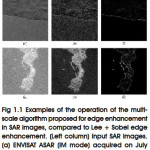 |
Figure 1.1: Examples of the operation of the multiscale algorithm proposed for edge enhancement in SAR images, compared to Lee + Sobel edge enhancement. (Left column) Input SAR images.
Click here to View figure
|
(a) ENVISAT ASAR (IM mode) acquired on July 24, 2003. (d) ERS1 (PRI image) acquired on July 19, 1993. (g) RADARSAT 1 acquired on September 26, 2003. (Middle column) Result of the application of the Sobel edge enhancement algorithm after Lee filtering with a window size of 11 × 11 pixels. (Right column) Result of the proposed algorithm for edge enhancement.
Existing system aims at presenting a novel method for edge enhancement in SAR images based on the exploitation of the information provided by the wavelet coefficients.
Proposed Work
Digital cameras generally include dedicated digital image processing chips to convert the raw data from the image sensor into a colour-corrected image in a standard image file format. Images from digital cameras often receive further processing to improve their quality, a distinct advantage that digital cameras have over film cameras. The digital image processing typically is executed by special software programs that can manipulate the images in many ways. Many digital cameras also enable viewing of histograms of images, as an aid for the photographer to understand the rendered brightness range of each shot more readily. The pixels in a digital photograph blend together scene components in seemingly irreversible ways and provide us precious little information about the scene’s apparent shape, illumination, and reflectance properties. Shadows are perhaps one of the most important illumination components in any photograph. They provide important visual cues for understanding shape, occlusion, contact between objects, and even surface texture. A shadow’s sharpness, shape, and colour depend on the shape of the light source, the geometry and opacity occlude, the reflectance properties of the shadowed surface, and the inter reflections among object within the scene.
Pre-processing is the initial step in image processing. Pre-processing is defined as preparing the image by removing the noise and enhancing the image. Sobel filtering is widely used in digital images before edge enhancement. Technically, it is a discrete differentiation operator, computing an approximation of the gradient of the image intensity function. At each point in the image, the result of the Sobel operator is either the corresponding gradient vector or the norm of this vector. The Sobel operator is based on convolving the image with a small, separable, and integer valued filter in horizontal and vertical direction and is therefore relatively inexpensive in terms of computations. On the other hand, the gradient approximation which it produces is relatively crude, in particular for high frequency variations in the image. The idea behind using sobel filter is to achieve some smoothing by giving more importance to the centre points.5
The Sobel operator is an algorithm for edge detection in images. It’s an important part of detecting features and objects in an image. Simply put, edge detection algorithms help us to determine and separate objects from background, in an image. The Sobel operator does this in a rather clever way. An image gradient is a change in intensity (or color) of an image. An edge in an image occurs when the gradient is greatest and the Sobel operator makes use of this fact to find the edges in an image. Algorithm based on Wavelet Transform is used here for edge enhancement in indoor digital images. Haar wavelet is used for the edge enhancement. Haar wavelet is a scalar type of wavelet transform.
The flowchart of the proposed algorithm is shown in Fig. 2.1. The rest of this paper is organized as follows. Section III Implementation which consists of section A Denoising, section B Sobel filtering, section C includes Density slicing; section D includes Edge enhancement method based on wavelet transform. Conclusions presented in Section IV.
Implementation Denoising
Denoising is the process of removing noise from a signal. The challenge is to preserve and enhance important features during the denoising process. Images taken with digital cameras will pick up noise from a variety of sources. Digital images are prone to a various types of noise. Noise is the result of errors in the image acquisition process that result in pixel values that do not reflect the true intensities of the real scene. Further uses of these images require that the noise will be removed.
There are several ways that noise can be removed from an image, depending type of noise present. Gaussian smoothing is very effective for removing noise. The weights give higher significance to pixels near the edge there by reduces edge blurring. Gaussian filter is a type of linear low pass filters. They are computationally efficient and rationally symmetrical. This behavior is closely connected to the fact that the Gaussian filter has the minimum possible group delay.
Sobel Filtering
To reduce the influence of noise when detecting edge, the Prewitt operator enlarges edge detection operator template from two by two to three by three to compute difference operator. Using the Prewitt operator can not only detect edge points, but also restrain the noise. The Sobel operator counts difference using weighted for 4 neighborhoods on the basis of the Prewitt operator. The Sobel operator has the similar function as the Prewitt operator, but the edge detected by the Sobel operator is wider.8 Sobel filtering is widely used in digital images before edge enhancement. Technically, it is a discrete differentiation operator, computing an approximation of the gradient of the image intensity function. At each point in the image, the result of the Sobel operator is either the corresponding gradient vector or the norm of this vector. The Sobel operator is based on convolving the image with a small, separable, and integer valued filter in horizontal and vertical direction and is therefore relatively inexpensive in terms of computations.
On the other hand, the gradient approximation which it produces is relatively crude, in particular for high frequency variations in the image.5 The idea behind sing sobel filter is to achieve some smoothing by giving more importance to the center points. Since the intensity function of a digital image is only known at discrete points, derivatives of this function cannot be defined unless there is an underlying continuous intensity function which has been sampled at the image points. With some additional assumptions, the derivative of the continuous intensity function can be computed as a function on the sampled intensity function, i.e. the digital image. It turns out that the derivatives at any particular point are functions of the intensity values at virtually all image points. However, approximations of these derivative functions can be defined at lesser or larger degrees of accuracy.
 |
Figure 3.1: a) Input indoor digital image b) Denoised image (using guassian filter c) Sobel Filtering
Click here to View figure
|
Before an image can be segmented, the objects in that image must be detected and roughly classified as to shape and boundary characteristics. Some techniques used to detect objects use a gradient operator to locate potential object boundaries or edges. The gradient operator applied to a continuous function produces a vector at each point whose direction gives the direction of the maximum change of the function at that point, and whose magnitude gives the magnitude of this maximum change. The Sobel operator represents a rather inaccurate approximation of the image gradient, but is still of sufficient quality to be of practical use in many applications. More precisely, it uses intensity values only in a 3×3 region around each image point to approximate the corresponding image gradient, and it uses only integer values for the coefficients which weight the image intensities to produce the gradient approximation. The Sobel operator can be implemented by simple means in both hardware and software: only eight image points around a point are needed to compute the corresponding result and only integer arithmetic is needed to compute the gradient vector approximation.5
The Sobel operator is an algorithm for edge detection in images. It’s an important part of detecting features and objects in an image. Simply put, edge detection algorithms help us to determine and separate objects from background, in an image. The Sobel operator does this in a rather clever way. An image gradient is a change in intensity (or color) of an image. An edge in an image occurs when the gradient is greatest and the Sobel operator makes use of this fact to find the edges in an image.
Density Slicing
Density slicing converts the continuous grey tone of n image into a series of density intervals, or each corresponding to a specified digital range. This technique emphasizes subtle grey-scale differences that may be imperceptible to the viewer.
Edge Enhancement The edge is a set of those pixels whose grey have step change and rooftop change, and it exists between object and background, object and object, region and region, and between element and element. Edge always indwells in two neighboring areas having different grey level. It is the result of grey level being discontinuous. Edge enhancement can perform prior to edge detection. Edge detection is one of the methods based on edge segmentation. There is always edge between two adjacent regions with different grey level, also widespread between the target and background
goals and objectives, elementary and elementary, which is an important basis for image analysis such as the image segmentation, shape features and texture features.4
Edge enhancement is an image processing filter that enhances the edge contrast of an image or video in an attempt to improve its acutance (apparent sharpness). The filter works by identifying sharp edge boundaries in the image, such as the edge between a subject and a background of a contrasting color, and increasing the image contrast in the area immediately around the edge. This has the effect of creating subtle bright and dark highlights on either side of any edges in the image, called overshoot and undershoots, leading the edge to look more defined when viewed from a typical viewing distance. The process is prevalent in the video field, appearing to some degree in the majority of TV broadcasts and DVDs3. A modern television sets “sharpness” control is an example of edge enhancement. It is also widely used in computer printers especially for font or and graphics to get a better printing quality. Most digital cameras also perform some edge enhancement, which in some cases cannot be adjusted. Edge enhancement can be either an analog or a digital process.
Digital image is defined as a 2- dimensional function f(x, y) where x and y are spatial co-ordinates and the amplitude of function at any pair of co-ordinates (x, y) is called the intensity or gray level of the image at that point. When x, y and the intensity values of function are all finite, discrete quantities, call the images as digital images.
The digital image contains a fixed number of rows and columns of pixels. Pixels are the smallest individual element in an image, holding quantized values that represent the brightness of a given color at any specific point. Typically, the pixels are stored in computer memory as a raster image or raster map, a two-dimensional array of small integers. The field of digital image processing is the study of algorithms for their transformation.
Algorithm based on Wavelet Transform is used here for edge enhancement in indoor digital images. Haar wavelet is used for the edge enhancement.1,6 Haar wavelet is a scalar type of wavelet transform. Wavelets are mathematical functions that cut up data into different frequency components, and then study each component with a resolution matched to its scale. They have advantages over traditional Fourier methods in analyzing physical situations where the signal contains discontinuities and sharp spikes. Wavelets were developed independently in the fields of mathematics, quantum physics, electrical engineering, and seismic geology.The wavelet transform can be expressed as∴

The Haar wavelet can be expressed as
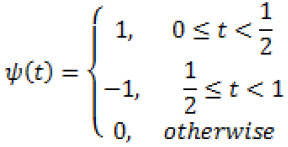
With this

Logarithmic operation
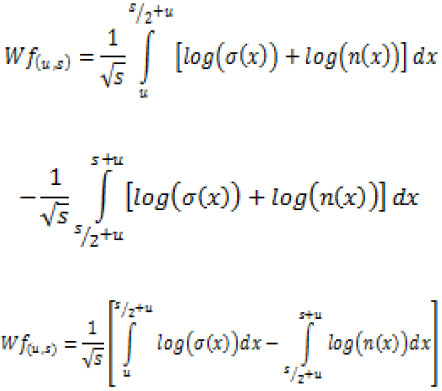

Wavelets are mathematical functions that satisfy certain properties and can be used to transform one function representation into another. Transforms like this have been around for many years. However, choosing the appropriate wavelet transform for a particular problem can provide a high compression ratio with no data loss.
The wavelet transform may be seen as the difference between the averaging of the curves over two adjacent intervals of the same duration. If the function is homogeneous along both intervals, the absolute value of the difference will be low. On the contrary, if there is a discontinuity in the trend of the curve, it will increase. Moreover, the maximum of this difference occurs when the discontinuity happens just in the frontier between the intervals. A combination of several scales in order to take benefit of the good performance in the resolution of the lower ones and in order to take benefit of the sensitivity to the presence of discontinuities of the higher ones.1
The combination is performed through an inter-scale point wise product which permits taking advantage simultaneously of the benefits of the span of the considered scales. Low values achieved with intervals of large lengths are reduced through the multiplication of the higher values present in higher scales. Moreover, due to their spatial co-occurrence, the local maxima that are due to a discontinuity contribute constructively when multiplying the scales. Since the energy that is due to the irregularity of the signal is mainly located at low scales, the resolution of the fine scales is preserved. Furthermore, while discontinuities that are due to the speckle do not persist, the ones produced by the presence of a meaningful edge propagate over the scales. As a consequence, the inter-scale point-wise product neglects the small isolated discontinuities. In the statistical characteristics of the multi-scale product are analyzed.1 It is known that the additive Gaussian noise is uncorrelated between scales and that the resulting distribution of probabilities is generally non-Gaussian heavy tailed.
An edge enhancement algorithm is proposed for edge enhancement in indoor digital images, which is reasonable and practical:
- Start with indoor digital image; it is useful to take the logarithm of the original signal in order to manage the noises.
- At each iteration of the SWT in two dimensions, three band-pass components are obtained, where each one enhances the discontinuities in a different direction. After normalizing each of these sub-bands to their maximum and taking their absolute value, the point-wise maximum across all of the three sub-bands is evaluated.
- A correct implementation of the algorithm deal with situations where a sub-band does not contain a vessel, as the proposed normalization may lead to noise amplification. In order to deal with this effect, an improved normalization step performs first an evaluation of the relative level of the noise floor with respect to the maximum in each wavelet sub-band.
- If a feature (i.e., a vessel) is present in a particular sub-band, the histogram shall be heavy tailed, and the normalization is performed as usual using the maximum of the corresponding sub-band. If not, the normalization factor is a number of times (usually three) the standard deviation in order to ensure low values on this sub-band.
- The components in the same scale are uncorrelated, taking the maximum value pixel per pixel permits avoiding as much as possible the speckle, which is contrary to an intra-scale combination. The same operation is carried out with different scales. Then, the different intermediate maxima previously calculated are combined through point-wise multiplication: For each pixel, the output value corresponds to the product of the values for that pixel of the intermediate maxima matrices obtained in the previous step.
- If necessary and if some kind of a priori information is available, the number of iterations can be adjusted accordingly. Otherwise, in common situations, five iterations suffice to provide satisfactory results regarding the usual range of the resolutions of indoor digital images.
To obtain a better separation between signal and noise, a threshold is set for the gradient image. Suppress the noise and highlight the major edges by zeroing all the pixels whose gradient is below a certain threshold. However, a small threshold value does not remove the noise effectively, while a high threshold eliminates some edge points and causes discontinuities in the edges. To solve this problem, a double threshholding method modified from Canny’s method can be used. To derive the final image, the local intensities of each image, as well as their correlation must be taken into account using the fuzzy logic.2
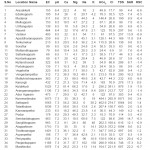 |
Table 1:
Click here to View table |
 |
Table 1:
Click here to View table |
Discussion
Given the examples of results for the edge enhancement using edge enhancement algorithm based on wavelet transform. An example of the operation on simulated images can be first considered. The images are denoised and performed filtering using sobel filter, the examples are shown in Fig 3.1. The result obtained after edge enhancement using wavelet transform is one pixel wide. Moreover, the correct performance of the method is also observed despite the diversity of scenarios.
Conclusion
Edge enhancement plays a vital role in digital image processing. Edge enhancement is an image processing filter that enhances the edge contrast of an image or video in an attempt to improve its acutance. The filter works by identifying sharp edge boundaries in the image, such as the edge between a subject and a background of a contrasting colour, and increasing the image contrast in the area immediately around the edge. In Indoor Digital image, edge enhancement is proposed by Edge Enhancement algorithm based on wavelet transform. Before that for removing the noises and enhancing the images preprocessing have to be performed. Sobel filtering is performed to filter the image. To find the tiny and low intensity pixels canny detection is proposed. Fuzzy logic is used to derive the final output. The proposed method can be applied in Robotics. The method can also be used for assisting physically challenged and impaired people.
References
- Mariví Tello Alonso,Carlos López-Martínez,Jordi J. Mallorquí and Philippe Salembier , “Edge Enhancement Algorithm Based on the Wavelet Transform for Automatic Edge Detection in SAR Images”, IEEE trans.Geosci. Remote Sens.,49(1) (2011).
- Farshad Faghih, Member, IEEE, and Michael Smith, Member, IEEE, “Combining Spatial and Scale-Space Techniques for Edge Detection to Provide a Spatially Adaptive Wavelet-Based Noise Filtering Algorithm”, IEEE Transactions on image processing, 11(9), (2002).
- Kaijun Tang, Jaakko Astola, “Multichannel Edge Enhancement in Color Image Processing”, IEEE Trans. Circuits and Systems, 4(5), (1994).
- Karen A. Panetta, Eric J. Wharton, “Logarithmic Edge Detection with Applications,” IEEE Journal of Computers, 3(9), (2008).
- Nick Kanopoulos ,Nagesh Vasanthavada, “Design of an Image Edge Detection Filter Using the Sobel Operator” , IEEE Journal of Solid-State Circuits, 23(2) ,(1988).
- Xin Wang, “Moving Window-Based Double Haar Wavelet Transform for Image Processing,” IEEE Trans . Image Process, 15(9), (2006).
- Y. Xu, J. B. Weaver, D. M. Healy, and J. Lu, “Wavelet transform domain filters: A spatially selective noise filtration technique,” IEEE Trans. Image Process., 3(6), pp. 747-758 , (1994).
- Feng-ying Cui and Li-jun Zou Bei Song, ” Edge Feature Extraction Based on Digital Image Processing Techniques” IEEE International Conference on Automation and Logistics Qingdao, China (2008).

This work is licensed under a Creative Commons Attribution 4.0 International License.

